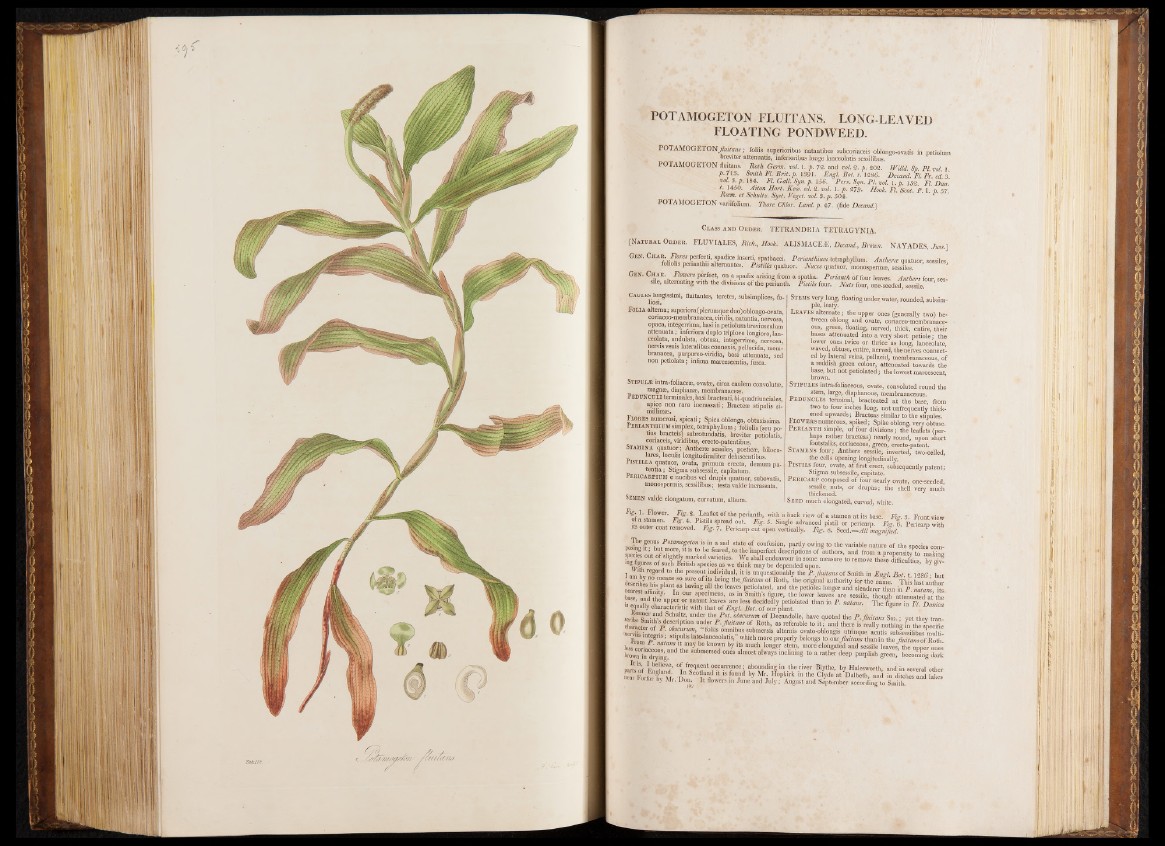
POTAMOGETON FLUITANS. LONG-LEAVED
FLOATING PONDWEED.
POTAMOGETONJluitam; foliis superioribus natantibus subcoriaceis oblongo-ovatis in petiolum
breviter attenuatis, inferioribus longe lanceolatis sessilibus.
POTAMOGETON fluitans. Roth Germ* ml. l. p. 72. and ml. 2. p. 202. JVilld. Sp. PI. ml. L
p.713. Smith Fl. Brit. p. 1391. Engl. Bot. t. 1286. Decand. Fl. Fr. eil. 3
ml. 3. p. 184. Fl. Gall. Syn.p. 156. Pars. Syn. PI. ml. 1 . p. 152. Fl. D ari,
t. 1450. Aiton Hort. K m . ed. 2. ml. 1. p . 279. Hook. Fl. Scot. P l p 57
Ram. et Schultz. Syst. Veget. ml. 3. p. 504. *
POTAMOGETON variifolium. Thore Chlor. Land.p. 47. (fide Decand.)
Class a nd Order. TETRANDRIA TETRAGYNIA.
[Natural Order. FLUV[ALES, Rich., Hook. ALISMACEÆ, Decand., Brown. NAYADES, Jims.]
Gen. Char .Flores perfecti, spadice inserti, spathacei. Perianthium tetraphyllum. Antheræ quatuor sessiles
foliohs penanthn alternantes. Pistilla quatuor. Nuces quatuor, monospermæ,sîssüeT *
GEN' T -a.spadix arisinS from a spatha- Perianth o f four leaves. Anthers four, sessile,
alternating with the divisions o f the perianth. Pistils four. Nuts four, one-seeded, sessile.
Caules longissimi, fluitantes, teretes, subsimplices, fo-
liosi.
Folia alterna; superiora(plerumqueduo)oblongo-ovata,
coriaceo-membranacea, viridia, natantia, nervosa,
opaca, integerrima, basi in petiolum breviusculum
attenuata; inferiora duplo triplove longiora, lan-
ceolata, undulata, obtusa, integerrima, nervosa,
nervis venis lateralibus connexis, pellucida, mem-
branacea, purpureo-viridia, basi attenuata, sed
non petiolata; infima marcescentia, fusca.
Stipüue intra-foliaceæ, ovatæ, circa caulem convolute,
magnæ, diaphanæ, membranaceæ.
PedüNCüli terminales, basi bracteati, bi-quadriunciales,
apice non raro incrassati ; Bracteæ stipulis si-
millimæ.
Flores numerosi, spicati ; Spica oblonga, obtusissima.
Perianthium simplex, tetraphyllum ; foliolis (seu po-
tius bracteis) subrotundatis, breviter petiolatis,
coriaceis, viridibus, erecto-patentibus.
Stamina quatuor; Antheræ sessiles, posticæ, bilocu-
lares, loculis longitudinaliter dehiscentibus.
Pistilla quatuor, ovata, primum erecta, demum pa-
tentia; Stigma subsessile, capftatum.
Pericarpium e nucibus vel drupis quatuor, subovatis,
inonospermis, sessilibus ; testa valde incrassata.
Semen valde elongatum, curvatum, album.
Stems very long, floating under, water, rounded, subsimple,
leafy.
Leaves alternate; the upper ones (generally two) be*
tween oblong and ovate, coriaceo-membranace*
ous, green, floating, nerved, thick, entire, their
bases attenuated into a very short petiole; the
lower ones twice or thrice as long, lanceolate,
waved, obtuse, entire, nerved, the nerves connected
by lateral veins, pellucid, membranaceous, of
a reddish green colour, attenuated towards the
base, but not petiolated; the lowest marcescent,
brown»
Stipules intra-foliaceous, ovate, convoluted round the
stem, large, diaphanous, membranaceous.
Peduncles terminal, bracteated at the base, from
two to four inches long, not unfrequently thick*
_ ened upwards; Bracteas similar to the stipules.
Flowers numerous, spiked; Spike oblong, very obtuse.
Perianth simple, of four divisions; the leaflets (perhaps
rather bracteas) nearly round, upon short
footstalks, coriaceous, green, erecto-patent.
Stamens four; Anthers sessile, inverted, two-celled,
the cells opening longitudinally.
Pistils four, ovate, at first erect, subsequently patent;
Stigma subsessile, capitate.
Pericarp composed of four nearly ovate, one-seeded,
sessile, nuts, or drupas; the shell very much
thickened. -
Seed much elongated, curved, white.
° f H'6 Peri“^ hi with a back view of a stamen at its base.1 Fig. 3. Frontview
4 ' Pistils spread out. Hg. 5. Slagle advanced pistil or pericarp. Fig. I . Pericarn with
its outer coat removed. Fig. 7. Pericarp cut open vertically. Fig. 8. Seed.—All magnified. P
The W f Fotamogcton is in a sad state of confusion, partly owing to the variable nature o f the snecies mm
Pperifsout^f\uahtiv markerT fc i to Hi6 thlPfh'fhbt descriptions of authors, and from a propensity^ making
inv fin t ° f sliglitly marked varieties. We shall endeavour m some mg figures of such British species as we think may be depended upon.m easure to remove these mdimfficcuuilntieess, bbyvt gr,iyv-
With regard to the present individual, it is unquestionably the P.fluitans of Smith in Engl. Bot t 1386 ■ but
f a c r i& i ” r f i f e b,“ "S of Roth, the ori/nal authority for the name. ThU M
aearestaffiiitP l “ mV‘"g S* the leav?s Peholated, and the petioles longer and slenderer than in P. nataris, its,
base 1 specimens, as in Smiths figure, the lower leaves are sessile, though attenuated at the
is \ uPPe!' °.r natant leaves *t» less decidedly petiolated than in P. natam. The figure in Fl Danic.a
>» equally characteristic with that of Engl. Bot. of our plant. 8 1 , uamca
J tS T ''-™d .Scha.Itz; undel; ‘he Pot. obscurum of Decandolle, have quoted the P . fluitans Sin ■ vet thev Iran
Sm c fe? „ f P T ' P,'°“ “f Roth, as referable to it; and there is really Nothing f n U i e l S j
nervii. ■ ob?cul.u,,‘’ f°his omnibus sufamersis altemis ovato-oblopgis utrinque acutis subsessilibus multi M oMI bel008S ,0 ‘han —
less coriafeouf d i, y nb l " T by “ ? much 'o”«61' stem’ more elongated and sessile leaves, the upper ones
brown in d“ ” g d ‘ 5° submer3ed ones “lmost “‘"ays '"^mug, to a rather deep purplish green, becoming dark
DarN of Ipbeli'eV? “hounding in the river Blythe, by Halesworth, and in several other
E Don 0‘ r fld “ 'S by in ‘h'i « y d e «D a lb e th , and in d itch ST ti la ta
1 by Ml> Don- lL flower9 in June and July; August and September according to Smith.